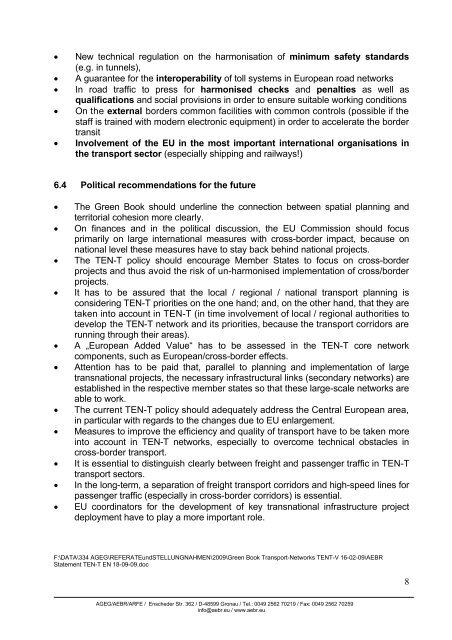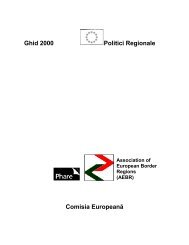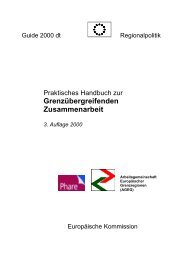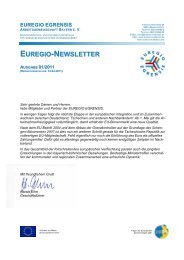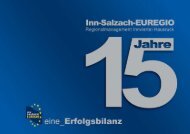GREEN PAPER - Association of European Border Regions
GREEN PAPER - Association of European Border Regions
GREEN PAPER - Association of European Border Regions
Create successful ePaper yourself
Turn your PDF publications into a flip-book with our unique Google optimized e-Paper software.
New technical regulation on the harmonisation <strong>of</strong> minimum safety standards<br />
(e.g. in tunnels),<br />
A guarantee for the interoperability <strong>of</strong> toll systems in <strong>European</strong> road networks<br />
In road traffic to press for harmonised checks and penalties as well as<br />
qualifications and social provisions in order to ensure suitable working conditions<br />
On the external borders common facilities with common controls (possible if the<br />
staff is trained with modern electronic equipment) in order to accelerate the border<br />
transit<br />
Involvement <strong>of</strong> the EU in the most important international organisations in<br />
the transport sector (especially shipping and railways!)<br />
6.4 Political recommendations for the future<br />
The Green Book should underline the connection between spatial planning and<br />
territorial cohesion more clearly.<br />
On finances and in the political discussion, the EU Commission should focus<br />
primarily on large international measures with cross-border impact, because on<br />
national level these measures have to stay back behind national projects.<br />
The TEN-T policy should encourage Member States to focus on cross-border<br />
projects and thus avoid the risk <strong>of</strong> un-harmonised implementation <strong>of</strong> cross/border<br />
projects.<br />
It has to be assured that the local / regional / national transport planning is<br />
considering TEN-T priorities on the one hand; and, on the other hand, that they are<br />
taken into account in TEN-T (in time involvement <strong>of</strong> local / regional authorities to<br />
develop the TEN-T network and its priorities, because the transport corridors are<br />
running through their areas).<br />
A „<strong>European</strong> Added Value“ has to be assessed in the TEN-T core network<br />
components, such as <strong>European</strong>/cross-border effects.<br />
Attention has to be paid that, parallel to planning and implementation <strong>of</strong> large<br />
transnational projects, the necessary infrastructural links (secondary networks) are<br />
established in the respective member states so that these large-scale networks are<br />
able to work.<br />
The current TEN-T policy should adequately address the Central <strong>European</strong> area,<br />
in particular with regards to the changes due to EU enlargement.<br />
Measures to improve the efficiency and quality <strong>of</strong> transport have to be taken more<br />
into account in TEN-T networks, especially to overcome technical obstacles in<br />
cross-border transport.<br />
It is essential to distinguish clearly between freight and passenger traffic in TEN-T<br />
transport sectors.<br />
In the long-term, a separation <strong>of</strong> freight transport corridors and high-speed lines for<br />
passenger traffic (especially in cross-border corridors) is essential.<br />
EU coordinators for the development <strong>of</strong> key transnational infrastructure project<br />
deployment have to play a more important role.<br />
F:\DATA\334 AGEG\REFERATEundSTELLUNGNAHMEN\2009\Green Book Transport-Networks TENT-V 16-02-09\AEBR<br />
Statement TEN-T EN 18-09-09.doc<br />
AGEG/AEBR/ARFE / Enscheder Str. 362 / D-48599 Gronau / Tel.: 0049 2562 70219 / Fax: 0049 2562 70259<br />
info@aebr.eu / www.aebr.eu<br />
8


